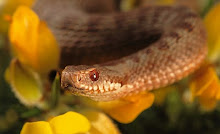Below is a link to my most recent wildlife column article, in colour with photographs. Page 33.
This will be available until 27/10/2010.
I have also pasted the text below if you want to read it after this date.
Ward's WildlifeForest Lords in Battle!Standing at an impressive 200cm in full antler, the fallow buck is our largest mammal in the Forest of Dean and during the month of October, it is the best time to hear and witness the rut, where they battle each other for the right to mate!
They will parallel walk before engaging each other – This involves walking next to each other until one turns to face the other. When this happens, the other buck will quickly turn and with all their strength, they lock antlers.
It is then down to strength and stamina as they force each other backwards into submission.
However, strength and stamina is not the only way of winning a fight! A well placed antler or a slip from the other buck can cause serious injury and even death!
If you are out walking in the forest you may hear the bucks calling from their stands. A deer stand can be identified by the severe thrashing of the nearby trees and also bare ground where they have scraped away the grass. The stands are also the buck’s territorial markers and as they patrol their territory, they call from each stand to herd and protect they’re doe’s.
The doe’s give birth in June after a gestation period of nearly 8 months, so they don’t get much of a break!
This is a time of year, rain or shine when I love getting out there before sunrise. The call of a fallow buck sounds like a mixture of a lion’s roar and a loud belch. Walking into the dark forest with these noises all around can be a bit spooky, but I get a buzz from the anticipation of what I might capture!
Once in the middle of the forest, I find a good location with clear views all around, not forgetting to select a location with a good solid tree that I can rest against.
I quickly erect a makeshift hide from dead branches and cammo netting to conceal myself and sit perfectly still and quiet.
You can sit there for hours without a decent view of a single deer, but a lot of patience and persistence is required if you want to get a decent photograph without disturbing them.
You cannot predict where a fight will happen and even though I have been photographing the rut for many years now, I have not managed to get a decent photograph of one. Maybe this will be my year!
Please remember – our forest is home to our wildlife and as we are supposedly intelligent human beings, we must put all the wildlife first and not disturb it, especially when they are mating.
Note: Please take extra care when driving the forests roads. The deer are more active at this time of year, especially during the early morning and late evening when the light is poor.
Road conditions can make it harder to stop and there are too many incidents on our roads involving our wildlife.
Take it easy and look after yourself as well as our wildlife!
Rob


















